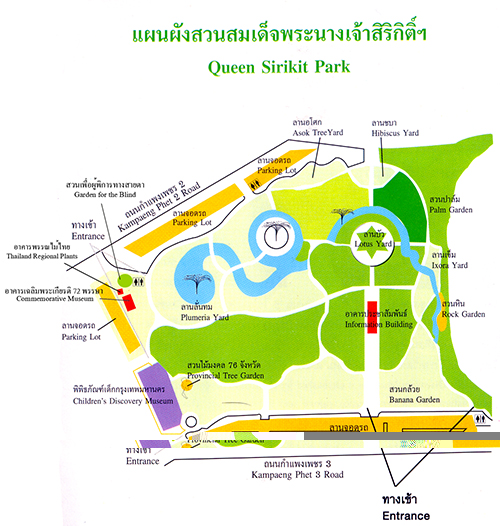 Situated between Kamphaeng Phet 2 Road and Kamphaeng Phet 3 Road, near Chatuchak Weekend Market, Queen Sirikit Park was established on August 12,1992 to commemorate the 60th birthday anniversary of HM the Queen. Situated between Kamphaeng Phet 2 Road and Kamphaeng Phet 3 Road, near Chatuchak Weekend Market, Queen Sirikit Park was established on August 12,1992 to commemorate the 60th birthday anniversary of HM the Queen.
The Park covers an area of 200 rai (120,000sq m), and was intended as a plantation following the concept of the diversity of plants in a forest. The park is also designated as one of Thailand's ideal botanical gardens, where more than 2,000 species of local and foreign plants are preserved.
This "Little Forest in a Big City" is nothing short of an oasis of ponds, pavilions, fresh breezes, and gentle birdsong. It is a perfect escape from Bangkok's never-ending bustle, a place for leisurely strolls and photos with friends and loved ones. It is also right next to Chatuchak Park (Suan Chatuchak) and Rotfai Park (Suan Rotfai).
Sirikit Park offers many attractions:
 The Winding Pool - This beautiful pool winds through the Park, its shape a combination of an 's' with the Thai letter 'sah seua', the first letter in the Queen's name. The pool is decorated with flowers and three fountains, which entertain visitors three times a day, at 7am, 12pm and 5pm. Come enjoy a relaxing atmosphere together with the movement and the splashing sound of dancing fountains accompanied by light music. The Winding Pool - This beautiful pool winds through the Park, its shape a combination of an 's' with the Thai letter 'sah seua', the first letter in the Queen's name. The pool is decorated with flowers and three fountains, which entertain visitors three times a day, at 7am, 12pm and 5pm. Come enjoy a relaxing atmosphere together with the movement and the splashing sound of dancing fountains accompanied by light music.
Botanical Gardens - Along the trail, visitors will see various kinds of plants grouped according to their botanical families, such as:
 The Banana Garden - Over 70 species are on display. The Banana Garden - Over 70 species are on display.
The Lotus Garden - Geometrically shaped pools are filled with colourful lotuses of many types, both local and foreign. The pools themselves are arranged as petals around a central circular pool. Various kinds of lotuses are planted in ancient jars which rest on granite platforms encircling the garden. The best time to enjoy the lotus garden is in the morning, from 6am to 8am when the lotuses are in bloom.
Visitors will be amazed by the beautiful flowers on display, including the Siam Ruby Lotus - both pink and white varieties - and the Victoria Waterlily, which changes colour according to its life cycle from white, when it is young, to purple at maturity. The landscaped beds along the walkway to the lotus garden are presented in European garden style.
The Hibiscus Yard - Brightly coloured hibiscus are presented.
The Asok Tree Yard - Each kind has different young / newborn branches which look like bunches of blossoms.
The Frangipani Yard - A large yard is filled with different kinds of charming frangipani, located along a canal near a fountain. In late afternoon, the flowers send sweet scent to permeate the garden air.
Along the Trails - Benches are placed under trellis roofs covered by climbing vines, creating deliciously shady spots for relaxation. The most special vine is the rare Yan Da-o or 'Golden Leaf Vine'. It has butterfly-shaped leaves, which are light green when young, and turn deep velvety red-brown when mature. These gorgeous leaves reflect the sunlight in shimmers of gold, giving the plant its name. This plant was found in 1970 by HM the Queen at Bayo Waterfall in a national park in the southern province of Narathiwat. It was brought to the park in 1996. Three years later it first gave golden leaves in Bangkok.
Another special favorite is Yan Lipao, a vine with little light green leaves. The Queen found this plant in a mangrove in Narathiwat. Her insightful projects have encouraged the revival of traditional skills as a means of increasing rural income. For instance, she encourages craftsmanship such as the making of distinctive handbags from Yan Lipao vines.
The Provincial Tree Garden - This garden is in the shape of a map of Thailand. Each province is represented by a tree local to that province.
 Building Commemorating HM the Queen's 72 birthday - There are displays of HM the Queen's work and projects concerning the conservation of our natural environment. Names and pictures of interesting plants in the garden are included. Currently the information is only in Thai, but park staffs are working to update it in English. Building Commemorating HM the Queen's 72 birthday - There are displays of HM the Queen's work and projects concerning the conservation of our natural environment. Names and pictures of interesting plants in the garden are included. Currently the information is only in Thai, but park staffs are working to update it in English.
The building is open Tuesday - Friday from 9:00 - 17:00, weekends and public holidays from 10:00 - 18:00. It is closed on Monday.
Three Buildings for Thai plants - Central and West; South and East; North and Northeast.
Trails inside each building are designated for local plants from each region. Lush greenery is scattered with colorful orchids and flowers.
Garden for The Blind - This is the first garden for the sight-impaired in Thailand. Visitors will enjoy nature and acquaint themselves with various species of aromatic plants by sense of touch and smell. The garden is equipped with Braille information signs, iron bars leading visitors along the trails, as well as speakers which automatically give information when visitors pass by.
Other attractions in the Park include Garden of Aromatic Plants and Plants from Thai Literature and Garden of Plants Concerned with the Thai Monarchy.
Queen Sirikit Park is a perfect venue for recreation as well as a learning centre about the flora of Thailand aw well as foreign lands.
Getting There:
By Taxi:
Visitors are suggested to mention the Thai name of the Park as ‘Suan Satharana Sirikit’, as well as describe to taxi drivers that it is located near Chatuchak Park and Rotfai Park. Otherwise, the drivers might think of Queen Sirikit National Convention Centre instead.
By Car:
Enter the park via the main entrance on Kamphaeng Phet 2 Rd. Parking is provided.
By Train:
The park is easy to reach from the Mo Chit BTS station or the Chatuchak Park MRT station. From either of these stations, walk along Kamphaeng Phet 3 Rd. to one of the park entrances.
By Bus:
Bus numbers 77, 122, 136, 145 and Air-con 145 stop at the park entrance on Kamphaeng Phet 2 Road.

< Close window> |
 Bangkok Attractions
Bangkok Attractions  Bangkok Attractions
Bangkok Attractions